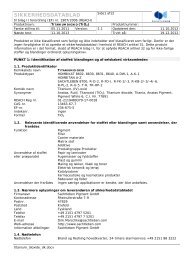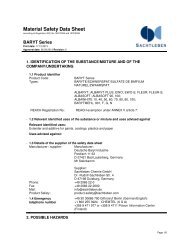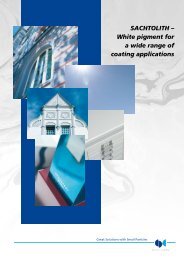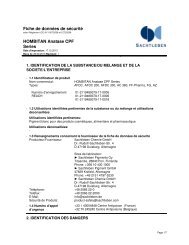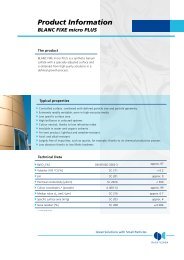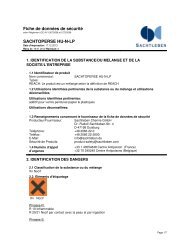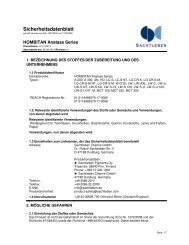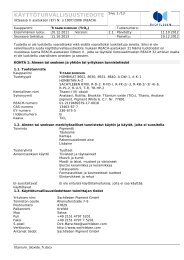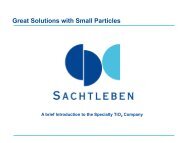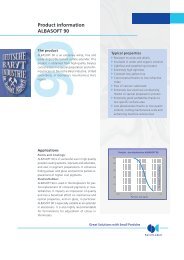Solutions for Masterbatches - Sachtleben Chemie GmbH
Solutions for Masterbatches - Sachtleben Chemie GmbH
Solutions for Masterbatches - Sachtleben Chemie GmbH
- No tags were found...
Create successful ePaper yourself
Turn your PDF publications into a flip-book with our unique Google optimized e-Paper software.
LITHOPONE 30%DSThe rheological and optical properties of LITHOPONE 30%DSassure significant technical and economic benefits <strong>for</strong> thisproduct in the preparation of white masterbatches. LITHO-PONE 30%DS is a co-precipitation of zinc sulfide and bariumsulfate and supplied by <strong>Sachtleben</strong> with a ZnS content of 30%.Thanks to its special secondary treatment and grinding (extremelylow sieve residue), LITHOPONE 30%DS possesses notonly optimum optical properties, but also outstanding dispersibilityin all thermoplastics, even at extremely high filling levels.By permitting partial replacement of TiO 2, fillers and polymers,LITHOPONE 30%DS enables masterbatch producers to achieveboth improved products and optimized cost-structures. It has,<strong>for</strong> instance, been demonstrated that the use of LITHOPONE30%DS in PE films increases the product‘s ultimate elongation;the impact strength of many thermoplastics (including PPand ABS, <strong>for</strong> example) was also improved. Proneness to lacingcan also be reduced when the TiO 2content is lower, sinceLITHOPONE 30%DS does not cause lacing itself. Of course,this effect is related to the chosen TiO 2grade as well. <strong>Masterbatches</strong>containing 50% TiO 2and 25% LITHOPONE 30%DSachieve the same or better hiding power than batches containing60% TiO 2(rutile), with a significantly higher extruder output.Processing costs are thus reduced, thanks to the modified fixedcostsstructure. The lower Mohs hardness of LITHOPONE 30%DSreduces abrasion in extruders compared to the use of TiO 2, withsignificant benefits <strong>for</strong> maintenance costs and intervals.• Resign demand 50% lower than with TiO 2• Reduced friction• Lower abrasive wear on the extruder compared to TiO 2• Higher extruder output <strong>for</strong> masterbatchand film production• LITHOPONE 30%DS should not be combinedwith HALS additives, as most are not sulfur stable• Packed goods should not be fumigated withmethyl bromide in order to prevent cross reactions(creation of di-methyl mercaptane)100%80%60%Approximately20% replacement oftitanium dioxide35% replacement ofpolyethyleneTio 2PolyethyleneLITHoPoNE 30%DSRule of the tHumb• Replace 1 part of titanium dioxide by 2.5 parts ofLITHOPONE 30%DS• Reduce the polymer share accordingly(keep overall 100%l)• Adjust replacement in a way, that the overall fillingdoes not exceed 75% (extruder) or 80% (kneader)40%20%0%ProcessiNg exampleParameter Base Formulation modified FormulationSide feeder 40% PE 25% PE60 % TiO 250% TiO 2Side feeder 2 - 25% LITHOPONE 30%DSCapacity Utilization 61% 48%Pressure of polymer melt 42 bar 54 barTemperatur of polymer melt 220º C 220º CSpecific energy up-take 0.095 kWh/kg 0.079 kWh/kgProcessing data of Leistritz ZSE 40 MAXX 48 L/DExtruder configuration: 2 side-feeder, <strong>for</strong>ward de-gassing, under-water granulationProcessing parameters: rpm screw 400 1/min /throughput 300 kg/h13



